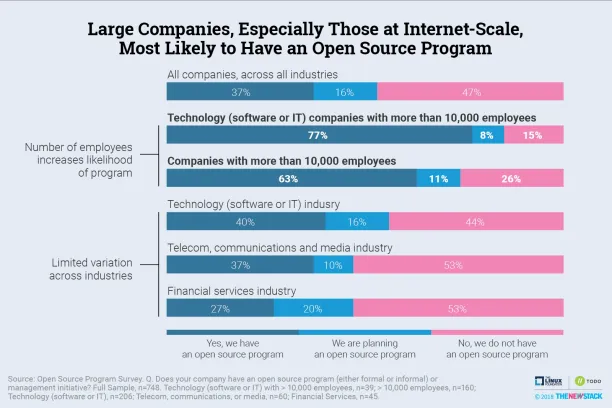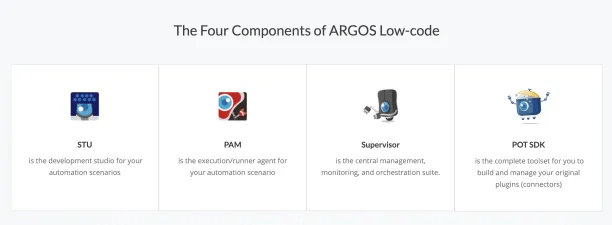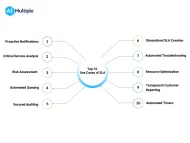Open Automation in 2024: Top Actionable Benefits & Vendors List
The global market size of open source solutions is expected to grow at 16.2% to reach $54.1B by 2027. Open automation is growing in popularity because it allows business users across the industry to implement more flexible, interoperable, and accessible automation systems. A survey of 748 people (Figure 1) showed that 63% of those who worked at large companies were using open automation software. This shows how popular open automation is (oas).

In this article, we will explain the concept of open automation in more detail. We will then explore the top benefits of open automation for businesses, with a specific focus on Python and RPA.
What is open automation?
Open automation refers to the concept of using open-source codes to develop and implement automation solutions. Open source automation fosters an open and collaborative ecosystem, encouraging innovation and lowering entry costs often associated with traditional proprietary technologies.
Open automation use cases aren’t different from any other intelligent solution or smart system, such as RPA or the Industrial Internet of Things for industrial automation. However, open automation solutions are more flexible, scalable, and cost effective. Also, the developers have more control over the tools and can customize the source code to meet the specific needs of customers or their organization.
What’s the top open automation software (oas) platform?
There are several open automation search platforms available, each with its own strengths and use cases. The following are some of the top open automation platforms:
- Argos Labs: Argos Labs’ low-code RPA platform is built on Python, enabling citizen developers to leverage its data sources to create customizable automation workflows. The biggest benefit of Argos Labs is that it’s Python native, meaning it can easily be integrated into existing software applications.

- Ansible: Ansible, now acquired by RedHat, can automate IT infrastructure tasks, such as server provisioning, configuration management, and application deployment.
- Jenkins: Jenkins is used for automated continuous integration and continuous delivery (CI/CD) of software projects.
- OpenNebula: OpenNebula is an open source cloud computing platform that can be used to automate the deployment and management of virtual machines and cloud services on a distributed network architecture.
- Puppet: Puppet allows system administrators to automate the deployment and management of software, configurations, and services across the entire infrastructure.
Note that this list isn’t exhaustive.
What are the benefits of open automation technology?
The positives of using open automation to build higher level systems such as ERP, advanced automation workflows, databases or large scale data logging centers include:
1. Cost savings
Open automation software can be less expensive than pre-packaged automation tools, as the hardware and the data sources are either free or available at low costs. This makes it easier for smaller organizations to adopt automation.
2. Customizability
Open automation solutions can be customized to meet specific business needs, as they can be modified and extended by developers. This means that organizations can tailor automation solutions to their unique requirements, rather than being limited by the features and functionality of proprietary solutions.
For instance, an Asian insurance provider deployed a vendor’s open source software on Microsoft Azure’s cloud to automate their “spreadsheet-based provisioning process.” Thanks to the tool’s human-readable language, the teams were able to customize the features to their liking and reduce the provisioning time from 3 months to an hour.
3. Flexibility
Open automation tools can flexibly be integrated into different applications. That’s because the underlying codes often leverage OPC UA (open platform communication unified architecture), OPC DA (open platform communication direct access) and net data connector for the exchange and processing of data points between different platforms.
For instance, D4Science is a virtual research environment providing services to support scientific research, collaboration, and data sharing. They created a continuous integration/continuous delivery (CI/CD) pipeline that is scalable, easy to maintain, and upgradable. This now allows them to support multi-project releases at scale, from over 200 Git repositories in a single day.
4. Community support
Open automation software is supported by developer and user communities. The development team can receive support, advice, and feedback from the contributors. Moreover, because developers are actively involved in maintaining the tools, fine-tunes and adjustments are carried more quickly. However, note that the open source tool’s maintenance depends on its number of active members. So some tools can have more contributors than others. For instance, Python’s GitHub page has around 6k followers, 120 active contributors, and 80 repositories. Moreover, thanks to its constantly-updating built-in libraries for cryptography, it can securely hash passwords and other sensitive data.
Lastly, videos, tutorials, and other additional information can ease the implementation.
5. Transparency
Open automation software is often more transparent than proprietary solutions, as the source code is available for anyone to inspect and audit. These components can increase trust and confidence in the solution, particularly for organizations that need to comply with strict regulations and standards.
6. Security
Because open source software is continuously maintained by a community, updates and security patches are released quickly. So once a security vulnerability is identified, the community can work together to create a patch and release it to the public. These capabilities mean the risk of data leaks in the future are minimized.
For more on process automation
If you like to learn more about our other researches on process automation, read:
And if you want to invest in a process automation solution, we have a data-driven list of BPA solutions.
We can help you in the selection process:

Cem is the principal analyst at AIMultiple since 2017. AIMultiple informs hundreds of thousands of businesses (as per Similarweb) including 60% of Fortune 500 every month.
Cem's work has been cited by leading global publications including Business Insider, Forbes, Washington Post, global firms like Deloitte, HPE, NGOs like World Economic Forum and supranational organizations like European Commission. You can see more reputable companies and media that referenced AIMultiple.
Throughout his career, Cem served as a tech consultant, tech buyer and tech entrepreneur. He advised enterprises on their technology decisions at McKinsey & Company and Altman Solon for more than a decade. He also published a McKinsey report on digitalization.
He led technology strategy and procurement of a telco while reporting to the CEO. He has also led commercial growth of deep tech company Hypatos that reached a 7 digit annual recurring revenue and a 9 digit valuation from 0 within 2 years. Cem's work in Hypatos was covered by leading technology publications like TechCrunch and Business Insider.
Cem regularly speaks at international technology conferences. He graduated from Bogazici University as a computer engineer and holds an MBA from Columbia Business School.
Sources:
AIMultiple.com Traffic Analytics, Ranking & Audience, Similarweb.
Why Microsoft, IBM, and Google Are Ramping up Efforts on AI Ethics, Business Insider.
Microsoft invests $1 billion in OpenAI to pursue artificial intelligence that’s smarter than we are, Washington Post.
Data management barriers to AI success, Deloitte.
Empowering AI Leadership: AI C-Suite Toolkit, World Economic Forum.
Science, Research and Innovation Performance of the EU, European Commission.
Public-sector digitization: The trillion-dollar challenge, McKinsey & Company.
Hypatos gets $11.8M for a deep learning approach to document processing, TechCrunch.
We got an exclusive look at the pitch deck AI startup Hypatos used to raise $11 million, Business Insider.
To stay up-to-date on B2B tech & accelerate your enterprise:
Follow on

Comments
Your email address will not be published. All fields are required.